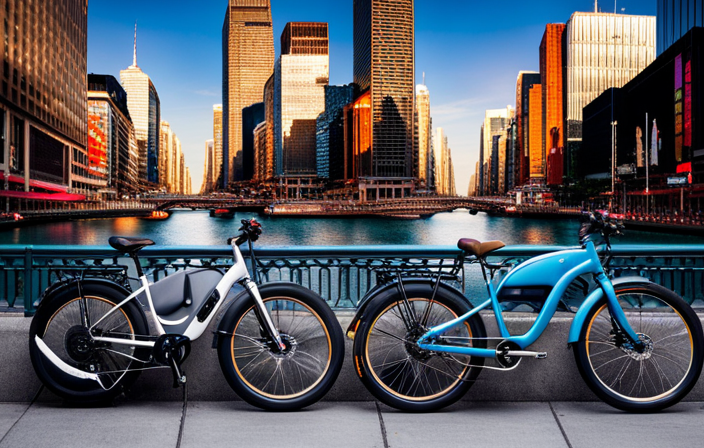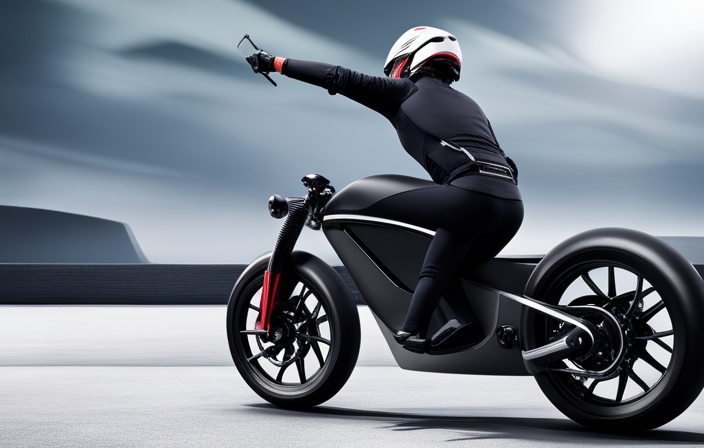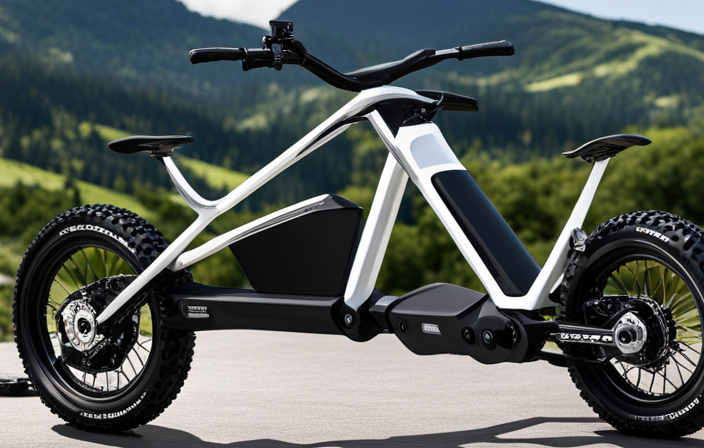Have you ever been curious about the origins of the electric bicycle? Get ready to be captivated by the intriguing history behind this groundbreaking form of transport.
From the early innovations in bicycle technology to the emergence of electric bicycles in the 19th century, this article will take you on a journey through time.
Discover the rise of electric bikes in the 20th century and the development of modern designs.
Get ready to explore the environmental benefits and the exciting future of electric bicycles.
Key Takeaways
- The first electric bicycle patents were granted in the late 19th century, with Ogden Bolton Jr. and Hosea W. Libbey being the pioneers in designing electric bike motors.
- Electric bicycles emerged in the 19th century and gained popularity among city dwellers, providing easier and faster transportation with the assistance of battery-powered motors.
- Electric bikes have advantages over traditional bicycles, such as the ability to cover longer distances without getting tired and assistance when riding uphill, making them a practical and efficient mode of transportation.
- Modern electric bike designs combine sleek aesthetics with advanced technology, including lightweight frames, powerful motors, and long-lasting batteries, further improving efficiency and performance.
Early Innovations in Bicycle Technology
You can learn about the early innovations in bicycle technology during this time period.
In the late 19th century, bicycle design was undergoing significant advancements. The introduction of the chain drive system allowed for more efficient power transfer, while the development of pneumatic tires improved ride comfort and traction.
These early advancements in bicycle technology laid the foundation for the later invention of the electric bike. It is important to understand the historical context in which these innovations emerged, as they influenced the subsequent development of electric bicycles.
Now, let’s delve into the first electric bicycle patents and explore the exciting world of electric bike invention.
The First Electric Bicycle Patents
The first e-bicycle patents were filed in the late 19th century. Inventors during this time were exploring early electric bicycle designs that would eventually pave the way for the modern electric bikes we know today. Here are four key facts about the historical significance of electric bicycles in this era:
-
The first patent for an electric bicycle was granted to Ogden Bolton Jr. in 1895. His design featured a rear-wheel hub motor powered by a battery.
-
In 1897, Hosea W. Libbey also filed a patent for an electric bicycle. His design included a motor integrated into the crankshaft.
-
By the end of the 19th century, electric bicycles were gaining popularity, especially among city dwellers looking for an efficient mode of transportation.
-
These early electric bicycle designs laid the foundation for the emergence of electric bicycles in the 19th century, marking a significant milestone in the development of alternative transportation.
Now, let’s delve into the subsequent section about the emergence of electric bicycles in the 19th century.
The Emergence of Electric Bicycles in the 19th Century
During the 19th century, the rise of electric bicycles revolutionized transportation options for city dwellers. Early electric bike designs emerged during this time, offering an alternative to conventional bicycles and horse-drawn carriages.
These early electric bicycles featured a battery-powered motor that provided assistance to riders, making transportation easier and faster. Interestingly, the early electric bike movement also saw the active involvement of women.
Women embraced electric bicycles as a means of independent transportation, breaking free from societal constraints. They found electric bicycles to be a convenient and efficient mode of travel, allowing them to explore the city and run errands with ease.
With the emergence of electric bicycles in the 19th century, a new era of urban mobility began to take shape. This laid the foundation for the rise of electric bicycles in the 20th century, ushering in further advancements in design and technology.
The Rise of Electric Bicycles in the 20th Century
In the 20th century, you’ll witness a significant increase in the popularity of e-bicycles. As urban areas expanded and people sought more efficient and eco-friendly modes of transportation, electric bikes became a popular choice. They offered several advantages over traditional bicycles, such as the ability to cover longer distances without getting tired and the option to use the electric motor when riding uphill. The table below provides a visual representation of the advantages of electric bikes in urban transportation.
| Advantages of Electric Bikes | Electric Bikes and Urban Transportation |
|---|---|
| Improved Range | Reduced Traffic Congestion |
| Easy Commute | Lower Emissions |
| Health Benefits | Cost Savings |
With these advantages, electric bikes quickly gained traction as a viable mode of transportation in urban areas. As we move forward, it is important to note the development of modern electric bike designs, which have further improved the efficiency and performance of these vehicles.
Development of Modern Electric Bike Designs
As urban areas expanded and people sought more efficient and eco-friendly modes of transportation, the popularity of electric bicycles skyrocketed. This led to the development of modern electric bike designs that combine sleek aesthetics with advanced technology. In recent years, there has been a surge in electric bicycle patents, with companies constantly striving to create innovative and cutting-edge designs.
These modern electric bikes feature lightweight frames, powerful motors, and long-lasting batteries, allowing riders to travel longer distances with ease. Some designs even incorporate regenerative braking systems, which help to recharge the battery while slowing down. With advancements in battery technology, electric bikes have become more practical and reliable for everyday use. They have also become more accessible to a wider range of riders, with options available for different terrains and riding styles.
Transitioning into the subsequent section about ‘electric bikes in popular culture,’ these modern designs have not only revolutionized transportation but have also become a symbol of sustainability and style.
Electric Bikes in Popular Culture
Electric bicycles have taken the world by storm, becoming a popular mode of transportation and a symbol of sustainability and style. In recent years, electric bikes have also made their way into popular culture, appearing in movies and music.
Filmmakers and musicians have recognized the appeal and versatility of electric bikes, incorporating them into their work to enhance the visual aesthetic and convey a sense of freedom and adventure. From action-packed chase scenes to laid-back cruising through city streets, electric bikes have become a common sight on the big screen.
In the world of music, artists have also embraced electric bikes, featuring them in music videos and album artwork. These appearances further solidify the electric bike’s place in popular culture and its status as a modern icon.
As electric bikes continue to gain popularity, advancements in battery technology are driving the next stage of their evolution.
Advancements in Electric Bike Battery Technology
Now that you have a better understanding of electric bikes in popular culture, let’s dive into the advancements in electric bike battery technology.
Over the years, there have been significant improvements in battery life, allowing riders to travel longer distances without worrying about running out of power. The latest lithium-ion batteries have higher energy densities, providing more power and longer-lasting rides.
Additionally, advancements in charging technology have made it easier and faster to recharge these batteries. Rapid charging stations are becoming more common, allowing riders to quickly top up their batteries during a pit stop. These advancements have undoubtedly made electric bikes more accessible and convenient for riders, eliminating the fear of being stranded with a dead battery.
With the improvements in battery life and charging technology, electric bikes have become a viable and reliable mode of transportation.
As we move forward, let’s explore the environmental benefits of electric bikes.
Environmental Benefits of Electric Bikes
Take a moment to consider the environmental benefits you can enjoy by choosing an electric bike as your mode of transportation.
Electric bikes have the potential to significantly reduce carbon emissions and air pollution. By opting for an electric bike, you contribute to a cleaner and greener environment.
In addition, electric bikes can help alleviate traffic congestion in urban areas, as they require less space and can maneuver through traffic more easily.
Moreover, investing in electric bike infrastructure can further enhance the environmental benefits. By developing dedicated bike lanes and charging stations, cities can encourage more people to switch to electric bikes for their daily commutes.
These initiatives not only reduce greenhouse gas emissions but also promote a healthier and more sustainable way of getting around.
As we move forward, let’s explore the current trends and future of electric bicycles.
Current Trends and Future of Electric Bicycles
Imagine the convenience and possibilities of hopping on an e-bike to zip through traffic and explore new routes effortlessly. Electric bicycles are currently experiencing a surge in popularity, with a growing number of people opting for this eco-friendly mode of transportation.
One current trend is the development of more powerful and efficient electric motors, providing riders with increased speed and range. Additionally, advancements in battery technology have made electric bikes more practical and affordable.
The future of electric bicycles looks promising, with ongoing research focused on improving battery life, reducing charging times, and integrating smart features such as GPS navigation and smartphone connectivity. These developments will further enhance the overall riding experience and encourage more people to embrace electric bikes as a viable alternative to traditional modes of transportation.
Transitioning to the next section, the impact and potential of electric bicycles cannot be overstated.
Conclusion: The Impact and Potential of Electric Bicycles
The impact and potential of e-bicycles cannot be overstated. They offer a convenient and eco-friendly mode of transportation with advancements in technology driving their popularity.
Electric bikes have had a significant impact on transportation. They provide an alternative to traditional modes of travel and reduce reliance on cars. With their ability to assist riders in pedaling, electric bikes make commuting easier and more accessible for people of all ages and fitness levels.
This has the potential to reduce traffic congestion and carbon emissions. As more people choose electric bikes over cars for short to medium distance travel, studies have shown that electric bikes can reduce carbon emissions by up to 90% compared to cars. This makes them a promising solution for sustainable transportation.
The potential for electric bikes to have an even greater impact on reducing carbon emissions and transforming transportation is immense. As technology continues to improve, the future looks bright for electric bikes.
Frequently Asked Questions
Are electric bikes more expensive than traditional bicycles?
Yes, electric bikes are generally more expensive than traditional bicycles. However, they offer numerous benefits such as easier transportation, reduced physical exertion, and the ability to go longer distances without getting tired.
How far can electric bikes typically travel on a single charge?
Electric bike range can vary depending on factors such as battery capacity, terrain, and rider weight. On average, electric bikes can typically travel between 20-50 miles on a single charge, but some models can go up to 100 miles or more.
Do electric bikes require a special license or registration?
No, electric bikes do not require a special license or registration. They are treated as regular bicycles in most places, as long as their top speed and motor power fall within the legal limits.
Can electric bikes be used in inclement weather?
You’ll be pleased to know that electric bikes can be used in inclement weather. They have the advantage of being able to handle wet conditions, but be cautious as they may have reduced traction and visibility.
Are there any restrictions on where electric bikes can be ridden?
Electric bikes can be ridden on most roads and bike paths, but there may be restrictions in certain areas like national parks or pedestrian-only zones. Safety concerns and environmental impact should be considered when riding in these spaces.
Conclusion
In conclusion, electric bicycles have come a long way since their inception in the 19th century. They have evolved from early innovations to modern designs, with advancements in battery technology driving their popularity.
One fascinating statistic is that by 2025, it is estimated that there will be over 300 million electric bikes in use worldwide. Just imagine the sight of countless electric bikes whizzing through city streets, contributing to a cleaner and greener environment.
The future of electric bicycles is bright, offering a sustainable and efficient mode of transportation for years to come.









